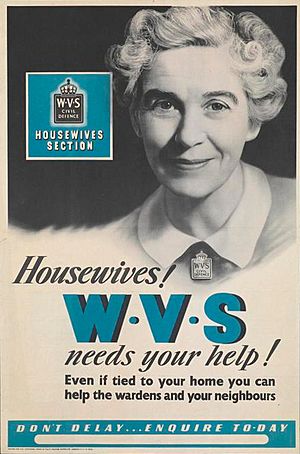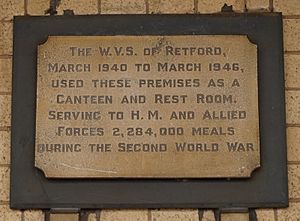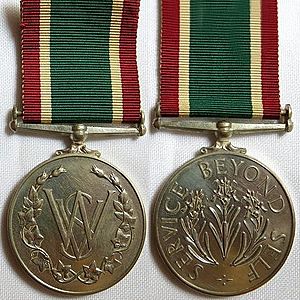Royal Voluntary Service facts for kids
 |
|
| Formation | 16 May 1938 (as the Women's Voluntary Service for Civil Defence) |
|---|---|
| Founder | Stella Isaacs, Marchioness of Reading |
| Legal status | Charity |
| Purpose | Helping people in need |
| Headquarters | Beck Court, Cardiff |
|
Patron
|
HM The Queen |
|
President
|
HM The Queen |
| Catherine Johnstone CBE | |
|
Formerly called
|
Women's Voluntary Service (WVS) 1938–1966 Women's Royal Voluntary Service (WRVS) 1966–2004 WRVS 2004–2013 |
The Royal Voluntary Service is a charity in the United Kingdom. It helps people who need support across England, Scotland, Wales, and Northern Ireland. It started in 1938 as the Women's Voluntary Service (WVS). Stella Isaacs, Marchioness of Reading created it. The main goal was to get women to help with Air Raid Precautions (ARP) in case of war.
Contents
What the Royal Voluntary Service Does
When the Women's Voluntary Service for Civil Defence began on May 16, 1938, it had clear goals. The government wanted women to join the Air Raid Precaution Services. They also wanted them to teach families what an air attack might mean. This included showing people how to protect themselves and their community.
Sir Samuel Hoare, who was Home Secretary, said the WVS was like the women's helper groups for the armed forces. Soon after it started, Queen Mary became its patron. Queen Elizabeth became its president in December 1938.
How the Organisation Was Set Up
The WVS/WRVS was a volunteer group. Lady Reading, its founder, wanted everyone to work together without ranks. This meant a duchess and a cleaner could work side by side. While there were no ranks, there were different titles for roles. Women signed up for specific jobs. These included driving ambulances, knitting, or collecting money for the war effort. Often, volunteers ended up doing many different tasks.
The WVS was divided into 12 regions, similar to the Civil Defence Corps areas. Each region had a paid administrator. Below them were county organisers and then local centres. During and after World War II, there were almost 2,000 WVS centres. These centres were important for helping local communities. Each centre had a leader called a Centre Organiser. They had teams for different tasks like helping with evacuations or managing food and clothing.
Centre Organisers sent monthly reports to headquarters. These reports helped share good ideas and kept everyone updated. These reports, from 1938 to 1992, are now part of the UK Memory of the World Register. They are important for understanding social and women's history.
Over time, the way the organisation was set up changed. In the 1970s, local government changes led to some centres closing. By the 1990s, local offices and centres were phased out. Headquarters moved from London to Oxfordshire in 1997. By 2004, there were no local or regional centres left. Services like Meals on Wheels were managed separately.
In 2013, the Royal Voluntary Service brought back the idea of local centres. They are now called 'Hubs'. Today, there are 67 Hubs across Great Britain.
Helping During World War II
Evacuation, Clothing, and Returning Soldiers
The WVS played a huge part in moving people from cities during the war. They helped find safe places for children to stay. Moving 1.5 million people, mostly children, out of cities in September 1939 was a big job.
The WVS also collected clothes for people in need. In 1939, Lady Reading asked the United States for help. This led to lots of clothing, called "Bundles for Britain", being sent by the American Red Cross. The WVS then gave these clothes out.
When soldiers returned from places like Dunkirk, WVS members met them at ports. They gave them food, drinks, and warm clothes. The WVS base at Headcorn, Kent railway station was very busy. They fed many returning soldiers there. The WVS also helped a lot during the Blitz, when British cities were bombed.
The WVS During the Blitz
During the Blitz, WVS women were experts at providing food and drinks all day and night. While ARP wardens and firefighters put out fires, WVS women set up mobile canteens. They served food to the workers, even though it was very dangerous. Buildings were collapsing all around them. After a raid, the WVS also helped the injured and those who lost their homes. Records show they helped over 10,000 people every night of the Blitz.
The Blitz lasted 57 nights. The WVS helped many people who went to their rest centres. Some stayed for a night, others much longer. In Barnes, one WVS member cooked for 1,200 bomb victims in one day, using her own kitchen.
The WVS's work during the Blitz was incredibly important. Their rest centres offered shelter, food, and toilets. But working so close to the bombing meant many WVS members were hurt. 241 members were killed during the Blitz, and many more were wounded. 25 WVS offices were destroyed.
Other Activities
The WVS set up Incident Inquiry Points (IIPs). These were places where people could find out about family members after a bombing. This helped free up ARP workers for other tasks. The WVS also helped with the Queen's Messenger Food Convoys. These convoys took food to bombed areas. After the Coventry bombing, one convoy served 14,000 meals.
By 1941, one million women were part of the WVS. Their work continued even after the Luftwaffe's bombing raids stopped. The Battle of the Atlantic caused shortages in Great Britain. The WVS helped collect materials for the war and taught people not to waste anything.
Each WVS centre had a Salvage Officer and a Food Leader. The Food Leader helped with food rationing locally. They made educational leaflets and held talks. The WVS also organised campaigns like Salute the Soldier Week and Wings for Victory Week.
Retford train station has a plaque honouring the WVS. The WVS at Retford served almost 2.3 million meals to British and Allied forces between 1940 and 1946. That's over 1,000 meals a day!
D-Day
Before D-Day, the WVS used their cooking skills again. They helped support troops. The skills they learned during the Blitz were useful when V-1 and V-2 rockets hit London. The WVS again played a key role in helping people evacuate. After D-Day was successful, the WVS went into Europe to support troops there. The first WVS members abroad landed in Italy.
WVS Groups Overseas
The WVS model worked so well that other countries started their own versions during the war. The British WVS helped them. India started a very successful group in 1942, especially in Bengal. It had over 10,000 members and continued into the 1950s. In the US, the American Women's Voluntary Services began soon after the war started in Europe. WVS groups also started in Canada and Australia.
Defence Medal
WVS members could receive the Defence Medal. This medal was given for home defence, just like to members of the emergency services.
After World War II
After the war, the WVS kept working because food rationing continued. The new government even funded the WVS.
In 1951, the W.V.S. Roll of Honour was created. It listed 241 WVS members who died during WWII. It toured British cathedrals and museums.
In 1952, Queen Elizabeth II became the patron of the WVS. In 1966, she allowed the service to add 'Royal' to its name. It became the Women's Royal Voluntary Service.
The organisation then focused on helping lonely and older people. They are very well known for their Meals on Wheels service. This delivers hot meals to people who cannot leave their homes. Their goal is to help people stay independent in their homes.
In 1968, the WRVS became a registered charity.
Today's Royal Voluntary Service
Today, the Royal Voluntary Service offers practical help to thousands of older people. This includes Meals on Wheels, Good Neighbours, and community transport.
They also run shops and cafés in hospitals. Any money they make goes back to the hospital to improve services for patients, staff, and visitors.
Royal Voluntary Service emergency teams help during major incidents. They supported people during the Lockerbie disaster, Hillsborough disaster, and floods. They set up rest centres and provided food to the public, firefighters, and police.
In 2004, the name changed from Women's Royal Voluntary Service to just WRVS. This was to make it seem more modern. Also, 11% of its 60,000 volunteers were men. In 2013, it changed its name again to Royal Voluntary Service. This was to make it clear that it's not just for women. About 5% of its volunteers are men today.
On March 24, 2020, during the COVID-19 crisis, the NHS asked for 250,000 new volunteers. The RVS helped manage these "NHS Volunteer Responders". More than 750,000 people volunteered to help vulnerable people.
In May 2024, Queen Camilla became the organisation's patron. She had been its president since 2012.
Uniforms Over Time
The WVS got its first uniform in June 1939. It was an overcoat and hat designed by Digby Morton, a famous London designer. The fabric was thick green/grey Harris Tweed from Harrods. The uniform was not free. In 1940, a full uniform cost about two weeks of an average man's wages.
The first free WVS uniform came in 1953. It was given to WVS members who were part of the Civil Defence Corps. This uniform included a dress, beret, and overcoat. Wearing a uniform was not always required. Many members wore WVS overalls or just their membership badge.
The WVS uniform changed little over the years. In 1966, the suits were updated to be more fashionable. In the 1970s, polyester fabrics were used. The WRVS stopped being a uniformed organisation in 1998. Today, volunteers can wear their own clothes with the organisation badge, or branded work-wear like polo shirts.
Royal Voluntary Service Medal
The Women's Voluntary Service Medal was created on March 23, 1961. Richard Butler, the Home Secretary, announced that Queen Elizabeth II had approved it.
The Royal Voluntary Service gives out this medal on behalf of the King. A volunteer can get it after completing forty duties each year for fifteen years. After another twelve years of service, they can get a clasp for their medal.
When the WVS became 'Royal' in 1966, the medal's name did not change at first. This was to be fair to those who received it before 1966. About thirty years later, the medal's name changed to the Women's Royal Voluntary Service Medal. This name stayed even when the organisation became the Royal Voluntary Service in 2013.
By 2015, about 35,000 medals had been awarded.





